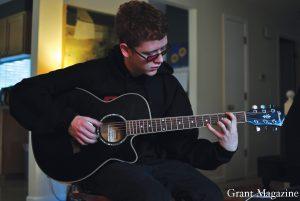Connor Garrett is passionate about academics. He’s fascinated by math and science. He’s a member of the Constitution Team. And he’s a talented musician.
But when people see the kid with the red-tinted glasses walking down the hall, some invariably wonder what he’s about.
When Garrett was two months old, his mom noticed something wrong. “His eyes moved in this funny, fluttery way all of a sudden that kept kind of going on and off,” Desiree Tournier remembers. 
After consulting with several doctors, an ophthalmologist diagnosed him with achromatopsia, a rare genetic visual impairment. Both Tournier and Garrett’s dad, Duane Garrett, had been unknowing carriers of the gene.
Tournier was concerned that her son might not be able to do things that most kids do with ease. That hasn’t been the case.
Garrett, a senior at Grant High School, is comfortable sharing what many might assume to be a sensitive topic. He says his sight is a part of who he is. Rather than dwell on what he can’t control, Garrett is using it to push himself forward.
“I’m just like anybody else,” he says. “I just can’t see as well.”
Born in 1996, Garrett seemed like a normal baby at first. He is the youngest child in a blended family. Tournier was excited to start a new life with her son. But with the diagnosis of Garrett’s achromatopsia, “I was pretty devastated,” Tournier remembers. “They basically told us he was gonna be legally blind.”
Tournier stayed positive. “I think the thing that I always did try to do, and that I think I did pretty well, is that I didn’t treat his vision like there was something wrong,” she says. “I treated it like it’s something different.”
She didn’t want her son to feel like a victim.
Achromatopsia is a disorder that afflicts roughly five percent of the world’s population. Those with the affliction have difficulty seeing colors because of a malfunction in the cones in the eyes that help process colors.
Garrett, though, isn’t completely colorblind. “My colors just aren’t as intense as yours,” he explains.
“I effectively fell off the face of the Earth in terms of how I related to people and what I did in school.” – Connor Garrett
His eyes are extremely sensitive to light and red blocks out more light than other colors, hence the tinted glasses. Because doctors cannot test what colors one can and cannot see, Garrett is not sure how much or little he is able to see like everybody else.
From a young age, Garrett learned to live with his visual limitations. The Oregon Commission for the Blind gave him a monocular that helps him see things in the distance, and they provided mobility training. The goal was for Garrett to be able to live in a normal environment. “It’s all about independent mobility,” Garrett says. “Being able to figure out how to get to places on your own. Because again, I’ll never be able to drive, so that excludes the main mode of transportation that most people would use.”
While growing up, Garrett dealt with other difficulties – most strikingly, the death of his father. Duane Garrett died in 2008 due to drug overdose-induced pneumonia that ended in cardiac arrest. Connor Garrett was 11 at the time. Although Garrett saw his father on and off, Tournier kept her son away from the negative part in his life.
Connor Garrett says that while he didn’t know his father well, it was still a blow. “I effectively fell off the face of the Earth in terms of how I related to people and what I did in school,” he recalls. “You have to understand (losing a parent is) not an easy thing to cope with.”
He struggled in middle school, he says, losing what he calls “my ability to succeed. I hated math with a fiery passion of a thousand suns,” Garrett recalls.
Rob Gibson, his sixth grade math teacher and later his eighth grade math and science teacher at the Fernwood campus of the Beverly Cleary School, watched Garrett grow throughout the experience. He noticed that Garrett focused more on drawing maps than on school. 
Gibson says he “would not have predicted that (Garrett) was going to become such a focused and able student, from how he was as a sixth grader or eighth grader. I’m very proud of him.”
It took Garrett until the end of his sophomore year to get excited about school again.
Grant math teacher Susan Shea remembers what it was like to teach Garrett during his sophomore year. She says his visual impairment “of course makes learning difficult to begin with, and he has found ways around it and all.
“In spite of that, he’s a voracious learner. He really wants to understand as much of it as he can, and he’s got an open mind, an open mind that is willing to do more than just open the textbook.”
She adds that although Garrett has some obstacles in his life, “he doesn’t let that get him down. I don’t think he feels sorry for himself for that.”
In his junior year, he auditioned for the a capella choir at Grant and made it. Music has always been a part of his life. Walk into Garrett’s home and the first thing you will notice are all the instruments, both common and foreign, arranged in the corners of different rooms.
“My mom bought me an electric guitar when I was 10,” says Garrett, who also plays piano. “And from then on I kind of just picked it up and it’s become kind of a life-long hobby.”
Garrett is especially talented with the guitar. For Garrett, “I just can’t take (music) seriously, it’s just too fun to me.”
In middle school, Garrett became friends with Andrew Pearson, drawn together by their shared hobbies with music. They later played together at their school talent shows. “We can talk about everything. We’re just both a big part of each others’ lives,” says Pearson, also a Grant senior.
Senior Ethan Eisemann describes Garrett as someone who “has one of the oddest senses of humor I have ever encountered, but in a good way. He’s always been a great person to have as a friend.”
Gibson sees that play out today. Every Wednesday, Garrett participates in teaching kung fu classes after school with his old teacher. Gibson says Garrett “brings that leadership and humor” to class, and he appreciates the help. “He’s an open-minded person, and he’s a very deep thinker, too, so he doesn’t make up his mind about how other people are,” Gibson says.
Along with kung fu, Garrett has discovered an interest in engineering. That interest is what connected Garrett with his now girlfriend, Anna Paxson, a senior at St. Mary’s Academy.
They met on an engineering field trip.
Paxson says she admires that Garrett “puts so much effort into everything he does.”
Garrett’s senior year is going very well. “Physics, math, all sciences I’m absolutely fascinated by,” he explains. He also finds history and civics intriguing. “I’m on Constitution Team, so law, and the way American law works, international relationships and diplomacy, and living in a global world” dominate his conversations.
He wants to study math or physics in college and dreams of attending the likes of the Massachusetts Institute of Technology or California Institute of Technology. “I’m not a big computer guy,” he says. “I’m a big engineer, and a person who draws stuff and calls that good. Test it, make it work.” 
At home, Garrett maintains a close bond with his mother. “They have a really good, impressively healthy relationship,” says Paxson. “They treat each other well. They take care of each other. It’s a sweet thing.”
Tournier, his mom, never looks back on his diagnosis as a drawback. Instead, she sees the value of what they have learned from the experience.
“We don’t know the purpose necessarily of things. We don’t know the bigger picture,” she says. “So you can take something like his achromatopsia and you could look at it as a tragedy.
“But then you can see later on that maybe it’s not. It has had a lot to do with what a great person he is, with how compassionate he is. I mean, he always wants to help other people and it’s made him grow in other ways.” ♦
































